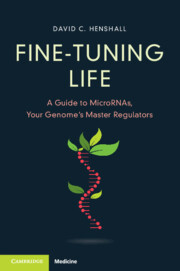Book contents
- Fine-Tuning Life
- Reviews
- Fine-Tuning Life
- Copyright page
- Dedication
- Contents
- Figures
- Ode to the MicroRNA
- Acknowledgements
- Common Terms and Definitions
- Introduction
- Chapter 1 Discovered!
- Chapter 2 MicroRNAs Emerge as Master Controllers
- Chapter 3 Epic Journey
- Chapter 4 Opening Act
- Chapter 5 MicroRNAs Shape the Machinery of Our Minds
- Chapter 6 Centre of the Electrical Storm
- Chapter 7 MicroRNAs Become Medicines
- Chapter 8 Circulating MicroRNAs Provide a Diagnosis
- Chapter 9 Finale and Encore for MicroRNAs
- References
- Index
Chapter 7 - MicroRNAs Become Medicines
Published online by Cambridge University Press: aN Invalid Date NaN
- Fine-Tuning Life
- Reviews
- Fine-Tuning Life
- Copyright page
- Dedication
- Contents
- Figures
- Ode to the MicroRNA
- Acknowledgements
- Common Terms and Definitions
- Introduction
- Chapter 1 Discovered!
- Chapter 2 MicroRNAs Emerge as Master Controllers
- Chapter 3 Epic Journey
- Chapter 4 Opening Act
- Chapter 5 MicroRNAs Shape the Machinery of Our Minds
- Chapter 6 Centre of the Electrical Storm
- Chapter 7 MicroRNAs Become Medicines
- Chapter 8 Circulating MicroRNAs Provide a Diagnosis
- Chapter 9 Finale and Encore for MicroRNAs
- References
- Index
Summary
In 2010, only a decade since microRNAs were discovered in humans, the first patient was treated with a microRNA drug, miravirsen, for hepatitis C virus (HCV) infection. This chapter opens with the discovery that HCV contained binding sites for miR−122, an abundant liver-specific microRNA. It looks at the research showing how the virus hijacks miR−122 to replicate, and the groundbreaking drug development programme that took advantage of this to create the world’s first medicine to target a microRNA. It covers some of the microRNA-based therapies further back in the drug development pipeline, discussing the relative strengths but also the risks of this approach. It explores the method to target microRNAs, including recent developments to disrupt single microRNA–target interactions to create precision microRNA therapies, and the viruses being commandeered to deliver microRNA treatments into specific cell types in the body. Lastly, it looks at how new microRNAs are being identified and considers the future of microRNA-based treatments, focussing on prospects for neurological disorders and reflecting on how, by listening to patients, we can create better and safer medicines.
Keywords
- Type
- Chapter
- Information
- Fine-Tuning LifeA Guide to MicroRNAs, Your Genome's Master Regulators, pp. 175 - 210Publisher: Cambridge University PressPrint publication year: 2024



